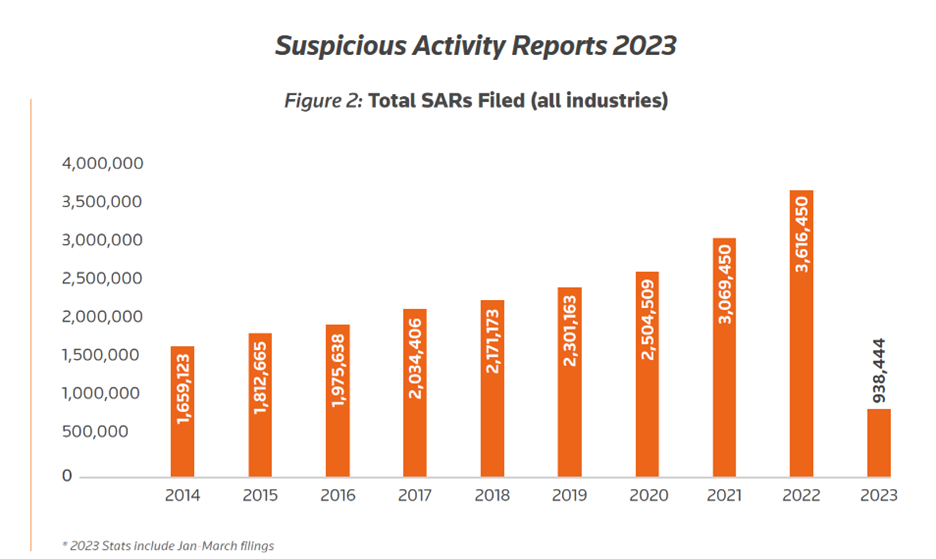Financial institutions’ tech and compliance professionals need to have a symbiotic relationship when it comes to filing SARs and making the most effective use of AI technology to make the filing process more efficient
At the forefront of global efforts to combat money laundering and financial fraud, Suspicious Activity Reports (SARs) stands as a pivotal document filed by financial institutions to report transactions that raise suspicions of such fraud or other illicit activities. This critical tool empowers regulatory agencies — such as the U.S. Treasury’s Financial Crimes Enforcement Network (FinCEN) — to track and combat financial crimes by providing valuable insights into potentially criminal financial activities.
The responsibility of filing SARs extends across many industries, including banks, credit unions, securities and futures firms, casinos, and money services businesses. Each sector plays a vital role in contributing to the collective effort to create a comprehensive overview of financial activities. This collaborative approach enables the identification of patterns indicative of potential criminal behavior, thereby reinforcing the interconnected nature of the global financial system.
The volume of SARs filed by financial institutions in the United States has witnessed a substantial surge, surpassing an impressive 3.6 million filings in 2022. This marks a significant 57% increase from pre-pandemic levels in 2019, signifying a robust response to the surge in fraud during the pandemic, according to a recent Thomson Reuters report.
The report, meticulously analyzing public data released by the FinCEN, paints a comprehensive picture of the current financial landscape. Notably, the report reveals that SARs filings have experienced notable spikes across various categories, including human exploitation, elder fraud, and government-related benefit scams, thus rendering vulnerable populations, such as migrants and the elderly, more susceptible to financial crimes.

In addition to pandemic-driven causes, the report sheds light on specific fraud trends, unveiling surges in check fraud and other payment-related frauds. Further, it identifies crucial seasonal patterns over the past nine years, emphasizing how January and February typically reflect below-average SARs filing volumes, while late spring and late summer often witness heightened activity. These insights provide not only valuable context but also strategic guidance for financial institutions as they navigate the intricate and evolving landscape of SARs reporting.
Common Issues with SARs
Despite their paramount importance, SARs are not immune to challenges, and several issues impact their effectiveness, including:
-
-
- Incomplete information — SARs often lack critical details, such as specific transactional information or contextual background, making it difficult for investigators to comprehend the full scope of the reported activity.
- Poor narrative quality — Many SARs narratives suffer from clarity issues, being either unclear or poorly written. This can impede investigators’ ability to extract relevant information efficiently and subsequently hinders the overall investigative process.
- High volume of reports — The sheer volume of SARs filings can overwhelm regulatory agencies, leading to delays in processing and analyzing the reports. The exponential increase in filings, while reflective of heightened vigilance, poses a logistical challenge for effective oversight.
- False positives — Financial institutions sometimes submit SARs for transactions that may appear suspicious at first glance but have legitimate explanations upon closer scrutiny. This results in unnecessary investigations, which can consume valuable resources and time.
-
How AI can assist in SARs filings
Consider a scenario in which a financial institution is faced with a surge in transaction data related to a specific customer, triggering suspicions of potential money laundering. Natural Language Processing (NLP) technologies can be a pivotal tool as it can apply artificial intelligence (AI) principles to words and phrases within a document, helping provide more context around what those words mean and how they function in the document at large.
The AI system efficiently extracts relevant data from various sources, and utilizing NLP, it analyzes the extracted data to identify patterns, anomalies, and potential red flags indicative of suspicious activity. This NLP system can leverage its understanding of the detected suspicious activity, so the AI system can autonomously construct a clear and detailed SARs narrative. NLP ensures that the narrative follows regulatory guidelines, includes relevant details, and effectively communicates the nature of the suspicious activity.
AI’s language generation capabilities ensure that the SARs narrative is coherent, concise, and adheres to regulatory language standards, checking for clarity, accuracy, and completeness in the narrative to enhance its overall quality. The AI system is programmed to customize SARs narratives based on specific regulatory requirements and reporting standards, and it can even adapt to the nuances of different jurisdictions, ensuring compliance with an ever-changing landscape of financial regulations.
While AI contributes to the initial narrative construction, the process also allows human analysts to review and refine the generated content. Human oversight ensures that the narrative aligns with the broader context of the investigation and incorporates any additional insights.
By automating the process of SARs narrative generation in this way, AI not only accelerates the reporting process but also improves the consistency and quality of the narratives submitted to regulatory authorities. Further, this collaborative approach between AI and human analysts ensures a thorough and well-constructed SARs narrative, strengthening the institution’s ability to combat financial crimes effectively.
The crucial role of investigators
While AI enhances the SARs reporting process for filers, investigators remain indispensable. Human expertise can bring contextual understanding, ethical considerations, and the ability to navigate complex scenarios that AI may struggle to grasp. Investigators play a pivotal role in interpreting AI-generated insights, validating findings, and making nuanced judgments that contribute to more effective and ethical financial crime investigations.
The incorporation of AI into the SARs reporting process represents a transformative shift in the battle against financial crimes. AI addresses prevalent challenges like incomplete information and sub-optimal narrative quality, empowering regulatory bodies and law enforcement agencies to proactively combat financial crimes.
As technology progresses, the synergy between human expertise and AI capabilities will be instrumental in upholding the integrity of the global financial system. The current upsurge in SARs filings — indicative of a surge in fraud — also underscores the imperative to embrace AI, enhancing the efficacy of this crucial financial crime prevention tool. Recognizing the indispensable role of investigators further underscores the significance of a harmonious integration of technology and human insight, leading to more precise, efficient, and ethical outcomes in SARs reporting.
In this evolving landscape, the symbiotic relationship between AI and human intelligence ensures a resilient and adaptive approach to countering financial crimes.







